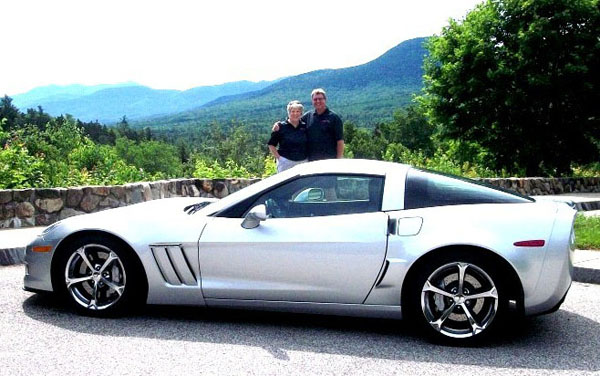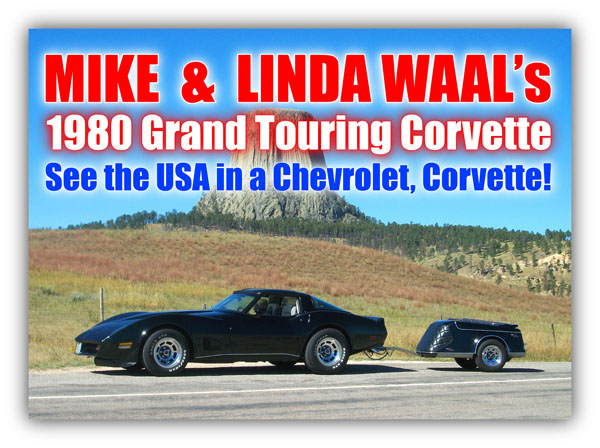See the USA in a Chevrolet, CORVETTE!
Dateline: 4-5-22 (this story was first published in the April 2018 issue of Vette Vues Magazine) – The term “GT” is arguably one of the most misused automotive designations. The term dates back to the 1930s in Europe and is an abbreviation for the words “grand touring,” or as they say in Italian, “Grand Turismo.” In the classic sense, a GT car was a road-going, lightweight, semi-luxurious coupe, built on a high-performance chassis. In the 1960s, American carmakers started to apply the GT term to many of their new pony and intermediate-size cars.
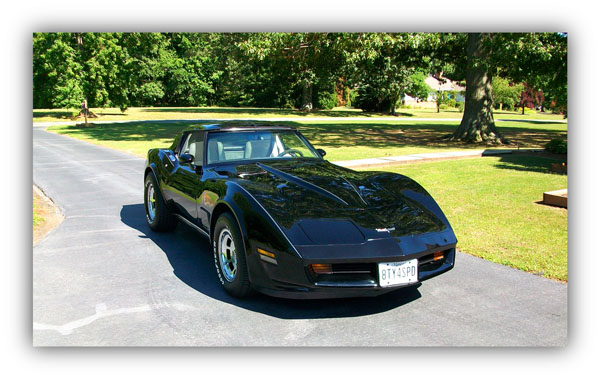
Carmakers such as Ferrari, Lamborghini, Austin-Martin, and others, all offered GT cars for their affluent customers. Today, the original GT cars look pretty spartan, but the concept had to start somewhere. Before we get into Mike and Linda Waal’s 1980 Corvette GT experiences, let’s set the context of their car.
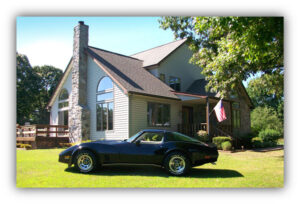 Even though the Corvette is an excellent platform for a GT car, Chevrolet never created a formal GT model. In the late 1970s and early 1980s Corvettes got a bad rap from the automotive press, but the public loved the car. 1979 still stands as the best sales year EVER for Corvettes, when a whopping 53,807 Corvettes were sold. No doubt this helped greenlight the approval for the C4 Corvette. But the automotive press was crewel to the car because it wasn’t a rip-snort’n pavement burner. The worst part of the 1979 Corvette was its weight, a 340-pound increase since 1968. So what was going on? It was just a convergence of increased safety regulations, tighter emission controls, and added creature comforts.
Even though the Corvette is an excellent platform for a GT car, Chevrolet never created a formal GT model. In the late 1970s and early 1980s Corvettes got a bad rap from the automotive press, but the public loved the car. 1979 still stands as the best sales year EVER for Corvettes, when a whopping 53,807 Corvettes were sold. No doubt this helped greenlight the approval for the C4 Corvette. But the automotive press was crewel to the car because it wasn’t a rip-snort’n pavement burner. The worst part of the 1979 Corvette was its weight, a 340-pound increase since 1968. So what was going on? It was just a convergence of increased safety regulations, tighter emission controls, and added creature comforts.
The C3 “Shark” Corvettes can be broken down into four groups; 1. 1968-1972 chrome bumper cars, 2. 1973-1977 soft bumper cars, 3. 1978-1979 fastback cars, and 4. 1980-1982 shovelnose fastback cars. The 1978-1979-fastback design was a beautiful execution that opened up the car’s interior. Too bad there wasn’t a hatchback until 1982.
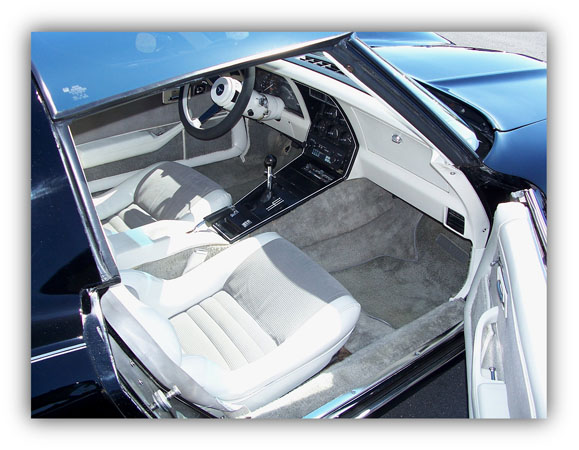
The 1980-1982 Corvettes showed that the Corvette engineers were indeed still serious about performance. The refreshed 1980 Corvette was around 238-pounds lighter than the 1979 model! Engineers accomplished this with; lower density roof panels, reducing the thickness of the hood and outer doors, use of an aluminum differential case and cross member, and the use of the L82’s aluminum intake manifold on the standard L48 engine. The new front and rear bumper covers reduced drag coefficient from .503 to .440. Also, the radiator airflow was increased by 50-percent. Horsepower for the 1980 base 350 engine was down 5-hp to 190-horsepower, but for the optional L82 was up 5-hp to 230-horsepower. Between improved aerodynamics and less weight the 1980 Corvette was a much-improved car.
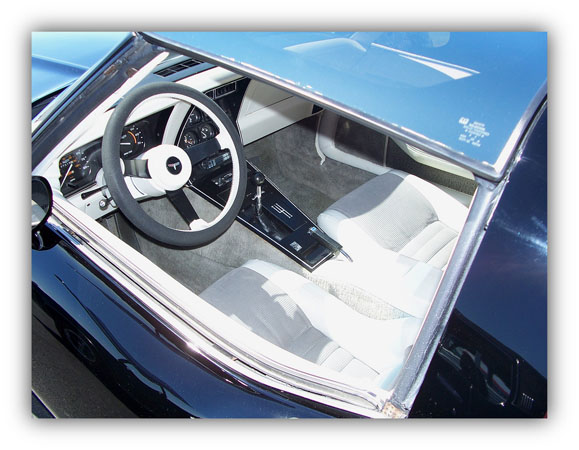
Getting back to the concept of “grand touring” or a GT car, the 1980 Corvette can be a good platform for long-distance travel. That’s exactly what Mike Waal had in mind when he decided to get back into a Corvette in 2007. Mike has been a sports car guy all of his adult life. Born and raised in Manhattan, Mike’s Dad worked for Cadillac at their showroom dealership on 57th Street and Broadway in Manhattan. Lucky for Mike, his Dad had access to all the car shows. Mike was about to turn six years of age, so he didn’t attend the 1953 GM Motorama where the first Corvette was introduced. Sometime between January 1953 and 1955, Mike attended his first car show with his Father. Mike recalls, “My Mom got me dressed in a suit with a white shirt and tie, put me on the subway train to meet my Dad. I saw my first Corvette up close and personal.”
As Corvettes were out of his price range, in his early years Mike and Linda owned and enjoyed a couple of Austin Healeys, took long trips with them, and competed in TSD Rallys. In 1976 Mike decided to sell his Austin Healey and purchase a Corvette for a change, and it’s been Vettes ever since. Mike’s first Corvette was a red 1973 L82 350/250, 4-speed, with a black interior and A/C. Mike says, “I always liked the poly front/chrome rear bumpers look.” Mike and Linda did some long-distance trips in the 12 years they owned the car. Eventually, he sold the car to his brother-in-law.
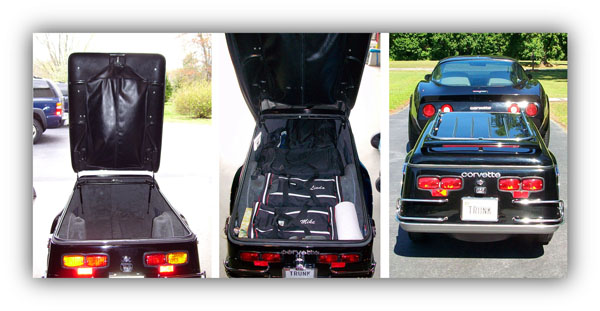
In 2007 when Mike decided it was time for another Vette, he knew what he wanted, another C3, and he knew what he wanted to do with the car; travel. Mike settled in on a 1980 Corvette for two main reasons. First, the car is devoid of any complicated electronics (as Mike put it, “No Captain Electronic Computerized Anything!”) and he wanted to be able to do most of the maintenance himself. And second, Mike felt that the final grouping of the C3 Corvettes, 1980-1982 were the best-looking and most finished. Engineers had pretty much worked out all the bugs.
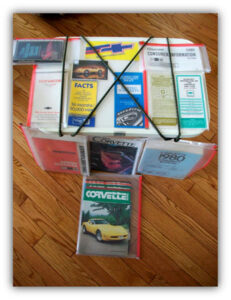
After a year of searching, in 2008 Mike finally found what he was looking for. His black 1980 Corvette has the base model L48 engine with 190-horsepower, a Borg-Warner Super T-10 4-speed manual transmission, Gymkhana Suspension, oyster cloth (2-tone light and medium gray) interior, power windows, tilt-telescopic steering wheel, power steering, and A/C. Mike already knew some interesting things about the L48 versus the performance L82. The L82 has 230-horsepower and 270 lb/ft of torque at 3600-rpm. The L48 only has 190-horsepower, however, it has 275 lb/ft of torque at just 2400 rpm. Yes, full torque (plus 5 extra lb/ft) comes on 1200 rpm sooner; perfect for a highway cruiser, and with 8.2:1 compression, the engine is never stressed. If maintained with the proper synthetic oil, it’s a 300,000-mile motor!
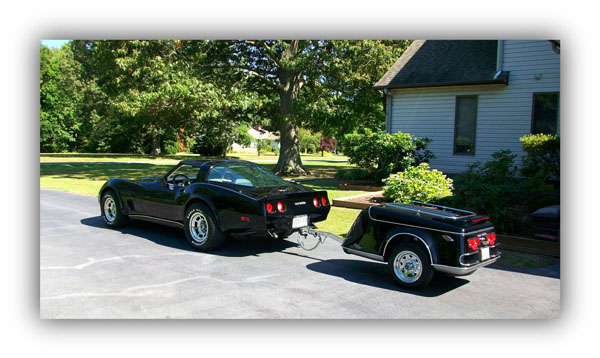
Mike had a long and successful 43-year career in the automotive tire industry, spending one-third of those with Michelin Tire Corporation, and later with other companies in regional and national sales positions, so he’s well-schooled in highway long-distance travel. Whereas most Corvette fans crave power and performance, what Mike wanted most was drivability, durability, and reliability. Here’s what Mike did to make his 1980 “Black Beauty” into a “Grand Touring” Corvette.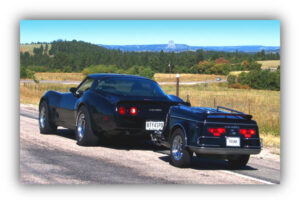
After finding maintenance records back in 1986, Mike learned that he is the fourth owner, the car has never been in a serious accident, and was repainted with factory color-correct paint. The engine was totally stock and had never been apart, according to the records he has. (St. Louis built a good one!) The car was in excellent condition but needed some work.
Systematically, Mike went through every component of the car to make sure there would be no failures. To date, here are the things Mike has replaced. Jim Glass Corvette specializes in C3 Corvette suspension work and replaced the 3.07 rear axle with a set of 2.88 gears to help lower RPMs at cruising speeds. Jim also worked on all of the suspension components, including; ball joints, upper and lower control arm bushings, tie rod ends, steering linkage, sway bar bushings (Mike kept the factory Gymkhana springs and sway bars), the rear control arms were replaced, and all four brake calipers were replaced with stainless steel sleeved units.
Mike had the Rochester carb rebuilt and re-jetted to be able to accommodate 10-percent ethanol fuel and the carb uses a K&N air filter inside the stock air cleaner cover. The alternator, water pump, fan clutch, and starter have all been replaced with GM stock parts, and the catalytic converter has been replaced.
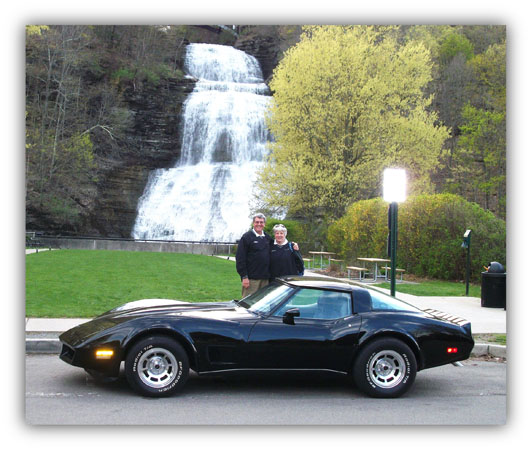
Lubrication for old cars is important for durability. Mike only uses Mobil 1 synthetic oils and greases for the engine, transmission, and differential. After a consult with Mobil, he chose to use their turbo diesel oil with 1100 PPM of phosphorus and 1300 PPM of zinc because of the flat-tappet cam in the L48 engine. The combo seems to work, Mike’s L48 gets 20-mpg on the highway while towing their motorcycle trailer, the engine temp is always perfect, and there’s plenty of low-end torque for highway travel. The car runs like a champ and is as dependable as anything new. Not too shabby for a 38-year-old automobile with 148,228 miles on the odometer!
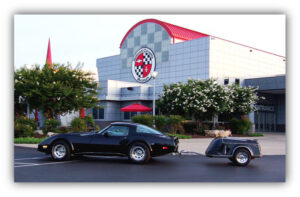
Now, about the black trailer with the Corvette badge on the back. Chevrolet never offered one, but they did offer a Trailer Package from 1977 thru to 1981 for just $105 in 1980. Trailer Package RPO-ZN1 included a heavy-duty radiator and the Gymkhana suspension. The trailer is actually a motorcycle luggage trailer and aside from the Corvette badge, that’s the way Mike bought it, rear spoiler, luggage rack, and all.
When Mike bought the car, Linda asked if there would be more luggage space than their 1973 Corvette. The 1973 Corvette has 4.4-cubic-feet of space, and the 2013 Corvette has approximately 24.4-cubic-feet of trunk space. Mike’s trailer has 25-cubic-feet of space and the hitch is loaded so that there’s hardly any load on the back hitch and tracks true with the car. The trailer has an air-ride adjustable suspension, radial tires for low rolling resistance, and fully loaded weighs 375-pounds. Traveling with the trailer is a breeze.
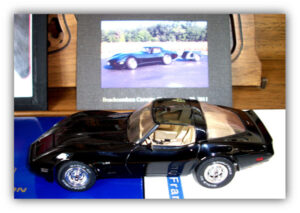
Mike and Linda Waal reside close to the Chesapeake Bay in Maryland and are active members of the First State Corvette Club, in Dover, Delaware. To date, they have traveled to Portland Oregon, throughout New England in the fall, and to Florida. Next is the southwest. One of Mike and Linda’s favorite places to go is Watkins Glen and stay at the famous Glen Motor Inn where all the sports car racing greats used to hang out. Watkins Glen is the birthplace of organized sports car racing in America.
Many times Mike has parked their Corvette in the exact same place Harley Earl parked his Le Sabre concept car in 1951 to watch the races. It’s where Earl got the idea that Chevrolet should build an American sports car. You could say, it’s the Corvette’s “Lover’s Lane”, where the Corvette was conceived. Yes, the Waals are enjoying their retirement years, seeing the USA in their 1980 Chevrolet Corvette. – Scott
Update – 4.5.2022: After careful consideration, Mike and Linda decided to update their GT ride with a newer Corvette. Just 3 years ago, in March 2019, and just before Covid, the Waal’s bought a 2013 C6 Grand Sport, equipped with the 6-speed manual trans option, and therefore the LS3 with Dry-Sump engine, hand-built by Chuck DeKubber, no less, at the GM Wixom Performance Build Center.
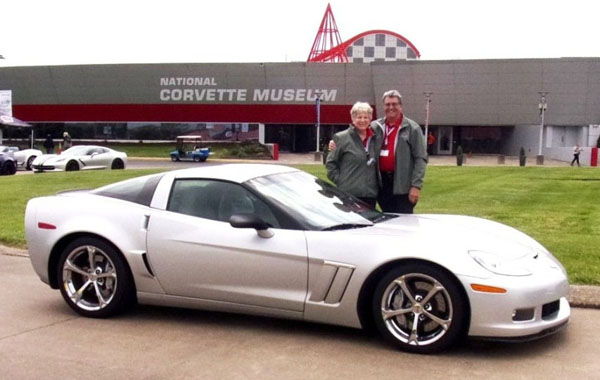
This GS was a perfect choice, having just turned 4,000 carefully maintained original owner miles, to use to “Find New Roads” and “See the USA”. Mike explained, “There wasn’t anything specifically wrong with our 1980 Corvette, it’s just that I thought, you know, the car is pushing 40-years of age. And even though I carefully went through all of the systems on the car, you never know. So, for the sake of piece of mind when on the road, we bought the Grand Sport.”
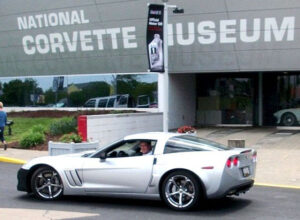
“The other plus for us is that there’s plenty of space in the C6 (22.4-cubic feet, the 1980 Corvette only had 8.4-cubic-feet ), enough that we don’t need to have the trailer! While the Black 1980 Corvette with its matching black motorcycle trailer got lots of thumb’s-ups from other motorists, it’s nicer driving without the trailer. The Grand Sport is an awesome car and we love it.”
“We’re C3 people, and within the subsets of C3 the 1980-82 body style, so in my mind, if there was ever a late model Corvette body style that was an evolutionary step forward from the 1980-82 C3, it is the C6 Grand Sport. Unfortunately, with the Covid situation the last two years, we weren’t able to do as many of the kinds of trips as we did with the 1980 Corvette.”
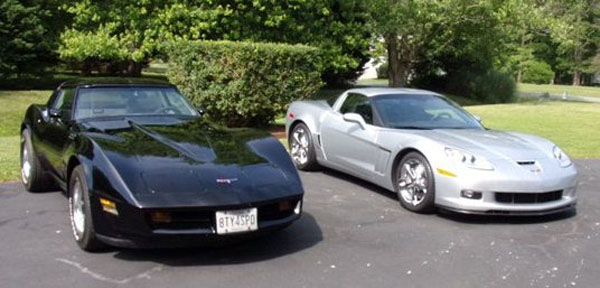
“We did, however, take a couple of very well-orchestrated ‘Covid’ planned trips; one to Deep Creek Lake of western Maryland, one to the White Mountains of New Hampshire where we drove the infamous Kancamagus Scenic Highway. And of course a few trips to the NCM for the 2019 and 2021 Michelin Bashes, and of course, a trip to one of our usual places, the Finger Lakes of New York, to participate in the 2021 Watkins Glen Grand Prix Festival.”
“And, yes, we did park Silver Bullet at the very same spot Harley Earl had parked his concept car, the La Sabre, to watch the 1951 Grand Prix races and gain inspiration to conceive the idea that America needed a sports car and GM/Chevrolet needed to build it.” – Thanks, Mike!
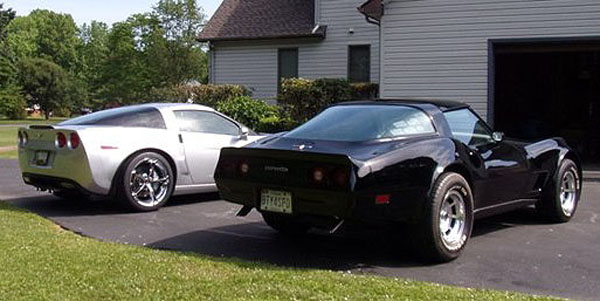
Many years ago I read that what Zora Arkus-Duntov wanted most of all (besides more horsepower and a mid-engine Corvette) was for his customers to “drive and enjoy” their Corvettes. Yes, Duntov considered Corvette buyers to be “his” customers. Corvette owners in the twenty-two years that Zora worked for Chevrolet, never had a better friend. And it’s nice to know that Mike and Linda Waal followed his instruction perfectly! – Scott
